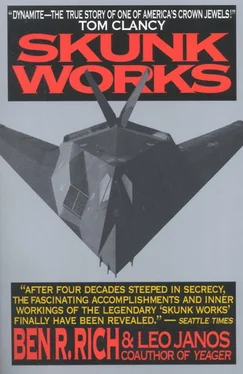Nevertheless, excessive government regulation is the penalty we now pay for years of overpromising and lax management in aerospace. At the heart of the defense industry problem was a recognition that if we bid unrealistically low to get a project, the government would willingly make up the difference down the line by supplying additional funding to meet increasing production costs. And it would do so without penalties.
Now if there are serious cost overruns, whether caused by unexpected inflationary spirals or even “no fault” acts of God, the company is liable to pay for it all or fix any mistakes from its own pocket. The era of the fixed-price contract rules supreme. As for major cost overruns, it is impossible to really surprise the government by suddenly revealing out-of-control expenses because every production line is swarming with government bean counters and inspectors keeping close tabs every step of the way.
Back in 1958, we in the Skunk Works built the first Jetstar, a two-engine corporate jet that flew at .7 Mach and forty thousand feet. We did the job in eight months using fifty-five engineers. In the late 1960s the Navy came to us to design and build a carrier-based sub-hunter, the S-3, which would fly also at .7 Mach and forty thousand feet. Same flight requirements as the Jetstar, but this project took us twenty-seven months to complete. One hint as to the reasons why: at the mock-up conference for the Jetstar—which is where the final full-scale model made of wood gets its last once-over before production—we had six people on hand. For the S-3 mock-up the Navy sent three hundred people. S-3 may have been a more complex airplane than Jetstar, but not thirty times so. But we were forced to do things the Navy Way.
In more recent years the government seemed determined to lower procurement costs through rigorous competition. One curious idea developed by Ronald Reagan’s secretary of the Navy, John Lehman, and adapted by the Air Force and other service branches as well, was something called leader-follower competition. The rule of this game was that the winner of a competitive bidding competition had to turn over his winning design to the loser. The loser would then learn how to build the winner’s product, and by the third year of production the loser would be allowed to bid on the project against the winner. For example, several years ago Hughes won the competition for an advanced medium-range attack missile against Raytheon, builder of the Patriot missile. The government bought four thousand of these missiles annually. The first year Hughes got the entire order. The second year, Raytheon, which had studied Hughes’s winning design, got an order to build one thousand while Hughes dropped to three thousand. By the third year, the government opened up the bidding to full competition and Raytheon won a majority of the buy. They were able to put in a lower bid because they had no initial research and development costs to factor into the price and they took over 60 percent of that missile’s production.
The leader-follower concept was an absolute outrage and a debacle. Fortunately, the Pentagon has since abandoned the idea, after admitting that there had to be fairer ways to lower costs, stimulate competition, and spread around new business among winners and losers.
In the so-called New World Order, defense-related procurements will undoubtedly continue to sharply decline into the foreseeable future, rendering the mountains of regulations and the battalions of inspectors and auditors irrelevant. Obviously, we will need continual defense spending and new technologies for as long as the world remains dangerously unstable. But now more than ever, I believe, the Pentagon and industry need to adapt the kinds of specialized management practices that have evolved out of the Skunk Works experience over the past half century.
My years inside the Skunk Works, for example, convinced me of the tremendous value of building prototypes. I am a true believer. The beauty of a prototype is that it can be evaluated and its uses clarified before costly investments for large numbers are made. Prior to purchasing a fleet of new billion-dollar bombers, the Air Force can intensively audition four or five, learn how to use them most effectively on different kinds of missions and how to maximize new technologies on board. They can also discover how to best combine the new bombers with others in the inventory to achieve maximum combat effectiveness.
One of the problems with our stealth fighter was that because it was hidden for years behind a wall of tight security, most Air Force tactical planners didn’t even know it existed and thus had no way of integrating the airplane into overall combat planning and strategy. By the time the F-117A arrived on station for duty in Operation Desert Storm, the airplane was largely a cipher to the high command in terms of its performance capabilities. After the war ended, Lt. General Charles Horner, in charge of Air Force operations, stated frankly that before the F-117A’s first combat mission, he was apprehensive about the effectiveness of stealth in combat. “We had a lot of technical data, but I had no way of knowing that we would not lose the entire fleet that first night of the war. We were betting everything on the data proving the technology—but we had no real experience with the airplane to know for certain how well it performed under fire. We sent those boys in naked and all alone. As it turned out, the data was right on the mark. But we should’ve known that before the first attack.”
As another streamlining improvement in the years ahead, the government should adopt the Skunk Works’ proven procedures for concurrency in manufacturing new airplanes or weapons systems. That is, new weapons systems or airplanes need not be endlessly perfected before production begins, provided that development proceeds carefully, avoiding the messes that both the B-1 and B-2 bombers got into when it was discovered that their avionics and weapons systems, independently produced, just didn’t fit into the strategy and design concept of the new bombers. Fixing it cost a fortune. The bottom line in concurrency development is cost savings, provided it is done right. Our experience on the stealth fighter proves it can be cost effective to build in improvements from production model to production model and keep within the budget and time frame contracted for. By the time we built stealth fighter number ten, we had enhanced many features that we were able to quickly install into the first nine models, because we had planned for concurrency from the beginning by keeping detailed parts records on all the production models and designing easy access to all onboard avionics and flight control systems.
Procurement should be on a fast track basis with a minimum of meetings, supervision, reviews, and reports. Whenever possible all parts on a new airplane should be commercially available, not specially made for military specs that are most often overkill and unnecessarily costly.
Another sound management practice that is gospel at the Skunk Works is to stick with reliable suppliers. Japanese auto manufacturers discovered long ago that periodically switching suppliers and selecting new ones on the basis of lowest bidders proved a costly blunder. New suppliers frequently underbid just to gain a foothold in an industry, then meet their expenses by providing inferior parts and quality that can seriously impair overall performance standards. And even if a new supplier does produce quality parts according to the specifications, his parts will not necessarily match those furnished by the previous supplier: his tooling and calibrations might be different, causing the major manufacturer extra costs to rework other system components.
For these reasons Japanese manufacturers usually form lasting relationships with proven suppliers, and we at the Skunk Works do the same. We believe that trouble-free relationships with old suppliers will ultimately keep the price of our products lower than if we were to periodically put their contracts up for the lowest bid.
Читать дальше












